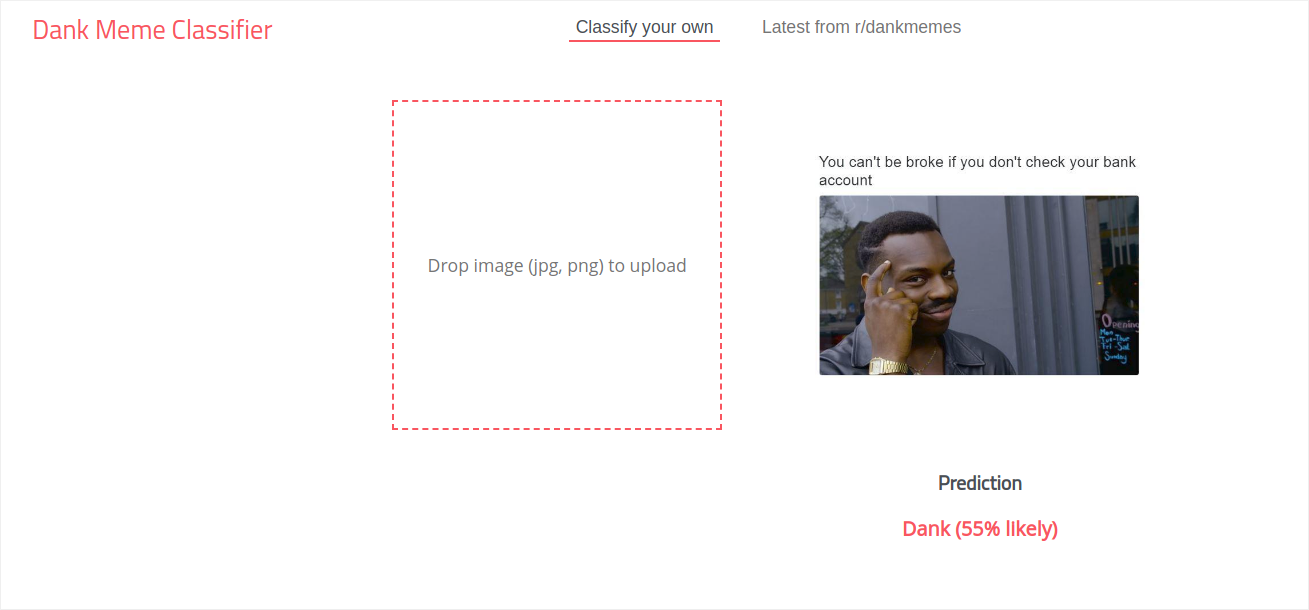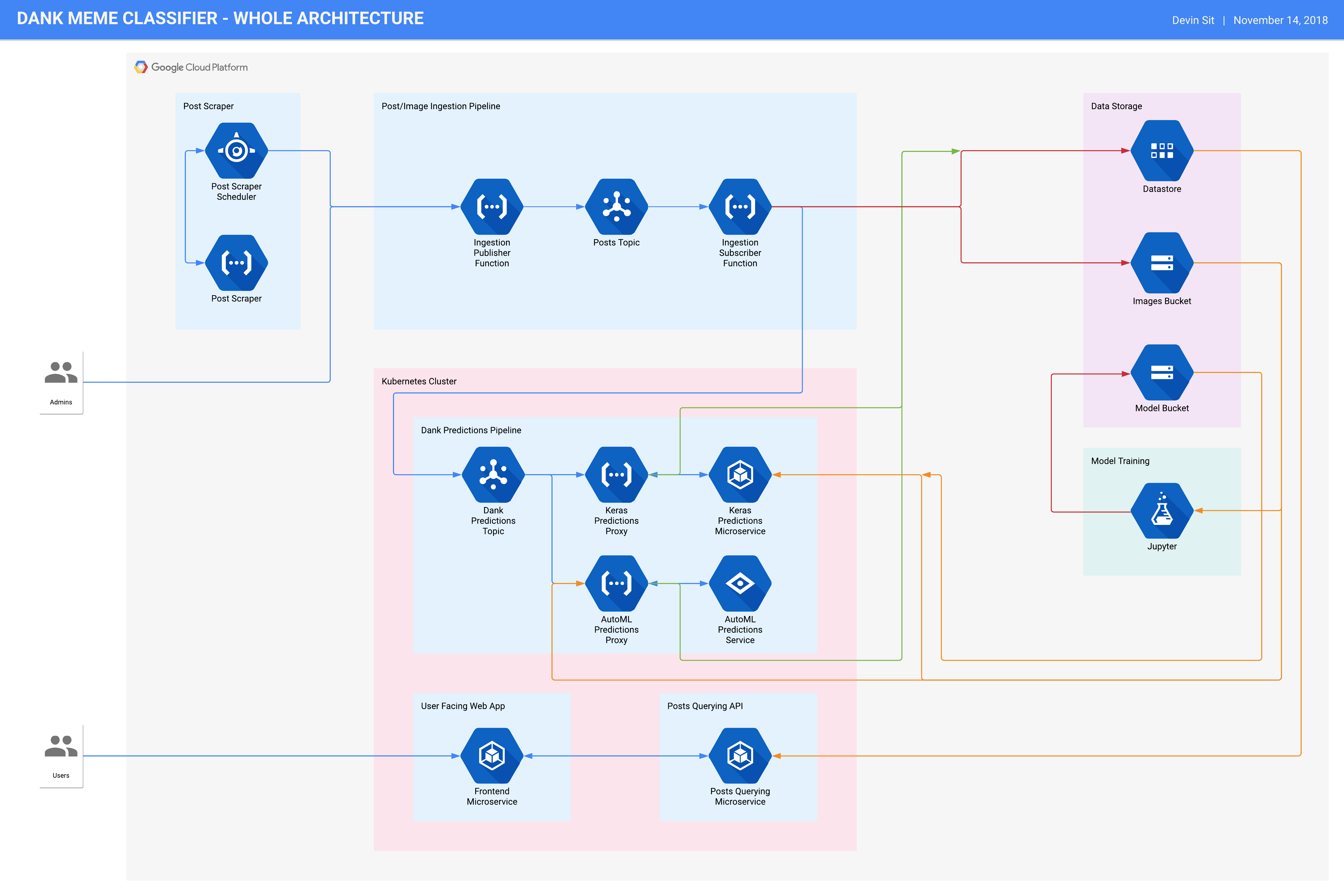For when you want to check if your memes are dank before sharing them!
The Dank Meme Classifier is a small React web app that uses machine learning to (intuitively enough) classify memes as either dank or not dank.
The Dank Meme Classifier can be accessed here.
- Why did I build the Dank Meme Classifier?
- Repo Structure
- Original Architecture and Tech Stack
- Demo Architecture and Tech Stack
- Local Development
- Contributing
- Authors
- License
The Dank Meme Classifier was originally built as a project for an Intro to AI course that I took in university.
The original goal of the project was simply to see if I could build a machine learning model that could take an image (i.e. a meme) as input and output a dankness score or dankness likelihood.
Due to the requirements of the project for the course, I also decided to do a comparison between a model that I would build (more-or-less by hand) and a model automatically generated by the Google Cloud Platform (GCP) AutoML Vision service (a service where all you do is upload a folder with a bunch of categorized images and it trains a model on them automagically).
Obviously, since I'm no expert data scientist, I didn't really expect to be able to build a model that could compete with AutoML (or that any model at all would be able to predict dankness likelihood). However, I was able to build a Convolutional Neural Network model with Keras that came within a handful of percent of the AutoML model.
Now whether or not either model was particularly accurate is still up for debate (both models had accuracy values in the high 50 percents), but considering the domain that we're working with here (dank memes), I settled with the fact that any particular meme is probably a coin-toss for dankness regardless.
As such, I took what I got and ran with it. I built a web app to wrap the two models and so that two dankness likelihoods could be provided: one for each model.
On top of allowing people to upload and classify their own images, I also setup a pipeline to ingest the latest memes from the r/dankmemes subreddit and display dankness likelihoods for those too.
The demo that is running at dankmemeclassifier.com is a pared-down version of the original project.
Since I wanted everything to run on GCP Cloud Run to keep costs down, I decided to cut out the AutoML model. I also cut out the r/dankmemes image ingestion since that also required extra infrastructure that I didn't want running just for this demo.
But you can still upload your own images and see if they're dank enough to be shared!
├── docs/ # Miscellaneous docs and images
├── ingestionPipeline/ # The pipeline for ingesting posts/images from the 'postScraper' into Datastore/Cloud Storage
├── modelBuilding/ # The notebook for building the Dank Meme Classifier model
├── postScraper/ # The cron job that periodically scrapes Reddit for the latest 'r/dankmemes' posts and feeds them to the ingestion pipeline
├── predictionPipeline/ # Sits behind a PubSub topic and handles forwarding the scraped images to the Keras/AutoML models for dankness predictions
└── webApp/ # The user facing web app (Frontend) and Backend that handles the Keras model
The architecture of the full version of the Dank Meme Classifier can be roughly described using the following diagram:
There are several components at play here.
Folder:
postScraperLanguage: JavaScript
Infrastructure: Cloud Function, App Engine Cron Scheduler
The Post Scraper was a GCP Cloud Function that was scheduled to fire on a regular basis by the App Engine cron service (note that this project was implemented in late 2018 -- before the introduction of the Cloud Scheduler service).
The Cloud Function would then scrape the r/dankmemes subreddit for the latest set of posts, and send the information (including post title, author, and the URL to the meme) off to the Post/Image Ingestion Pipeline.
Folder:
ingestionPipelineLanguage: JavaScript
Infrastructure: Cloud Function, PubSub
This ingestion pipeline starts as another Cloud Function that would receive the post information from the Post Scraper. It would then take the list of posts and chunk it up into smaller lists before feeding each smaller list to a PubSub topic.
The PubSub topic would then publish each smaller list to another Cloud Function. Each list would be given to an individual instance of the Cloud Function so that they could all be processed in parallel. The Cloud Function would fetch the images, process them, and then store them into a Cloud Storage bucket (as well as storing the post metadata into Datastore).
The reason to do all of this was scalability. Although the Post Scraper service only scraped a small number of posts during its scheduled runs, it was originally used to gather all of the 30,000 odd images that were used to train the Keras model.
As such, having the whole image ingestion pipeline run entirely in parallel sped up the process to the point of taking just a handful of minutes for all those images.
Folder:
predictionPipelineLanguage: JavaScript
Infrastructure: Cloud Function, PubSub, AutoML Vision
Once the images had been ingested, another PubSube topic would be notified that the images were ready for dankness predictions. The topic would notify two other Cloud Functions: one for my home-grown Keras model, and one for the AutoML model.
These Cloud Functions, however, merely acted as proxies for the actual prediction services. The Keras Predictions service ran as part of the web app's Backend service on a Kubernetes (GKE) cluster, whereas the AutoML Predictions service was GCP managed.
Once the predictions had been made, these too were saved to Datastore. Note that throughout all of this, the hash of each image was used for identification. This way, even if the same image was ingested multiple times, as long it hashed the same, then it wouldn't be processed/stored multiple times.
Folder:
webApp/frontendLanguage: JavaScript
Framework: React
Infrastructure: Docker container hosted on Kubernetes
Once a user finally wanted to interact with the app, this is what they'd be dealing with. This was a React service hosted as a container on a Kubernetes cluster.
The Frontend handled calling out to the Posts Querying API (aka the Backend -- see below) to grab the predictions for the latest set of r/dankmemes posts. Additionally, it also enabled users to upload their own images to predict for dankness.
Folder:
webApp/backendLanguage: Python
Framework: Flask, Keras
Infrastructure: Docker container hosted on Kubernetes
The last piece of the puzzle, this service acted as a middleware between the Frontend (aka the User Facing Web App) and the data stored in Datastore/Cloud Storage. It handled requests from the Frontend to look up the latest posts and URLs to the memes.
The Posts Querying API was actually only half of the Backend service; the other half was (as noted earlier) the Keras Predictions service. Yes, this one Flask API handles both duties!
From a scalability and microservices perspective, it probably would have been better to split these two duties apart, but it was simpler and easier to keep them together since they both needed to share code. Also, raw performance wasn't exactly a problem here.
There were three main storage solutions that were used for this app:
- Datastore: A simple NoSQL database that handled storing Reddit post metadata, image URLs, and prediction values.
- Images Bucket: A Cloud Storage bucket that stored the processed images from the Ingestion Pipeline that would be predicted upon in the Dank Predictions Pipeline.
- Model Bucket: A Cloud Storage bucket that stored the finished Keras models. The models would then get replicated from the bucket to an NFS share on the Kubernetes cluster for use by the Keras Predictions service.
Model training was done using Google Colab, a hosted Jupyter solution with access to (free!) Titan K80 GPUs for training.
Training consisted of using a set of 30,000 images that were pulled from the r/dankmemes subreddit. The methodology I used was as follows: using a set of the most and least upvoted posts on the subreddit, I would classify each image as dank if it was highly-upvoted and 'not-dank' if it was barely upvoted at all.
That is, I would use the post's Reddit score as a proxy for whether or not a meme was dank. Intuitively, this would make sense since people in the subreddit called dankmemes should theoretically upvote the memes that are the most dank. Obviously, this unlike to be true 100% of the time, but it seemed like a good enough approximation given the domain.
Once I had my set of images all split up into dank and not-dank, I then split it once again into the training and validation (or test) sets. The training set would end up being 80% of the total image set -- 24,000 images -- while the test set would be 6,000 images.
Finally, it then just became a process of figuring out how to actually train a machine learning model. I eventually learned that it would be easiest (i.e. least time-consuming) to do transfer learning on an existing Convolutional Neural Network architecture than try and piece together a network from scratch (or from a whitepaper).
As such, I took one of Keras' built-in models -- the VGG16 -- and lopped off its final fully-connected layer before trying many, many different combinations of other layers.
In the end, I was able to produce a model with a validation accuracy of roughly 57%; not much better than a coin toss, but still better than a coin toss. Considering the automagically-generated AutoML model that I was competing against was at around 60%, I felt pretty good.
Obviously, the process I went through for building and validating the model was far from rigorous, but hey, for a non-data-scientist, it sure looked pretty good! And it seemed to get a couple of chuckles out of people too 😃
The Jupyter notebook that was used to generate the final Keras model can be found in the modelBuilding folder.
The demo version of the Dank Meme Classifier (what is currently available at dankmemeclassifier.com) simplifies the above by quite a bit.
It consists of just the Frontend and Backend services that make up the web app (found in the webApp folder).
The Frontend (i.e. the User Facing Web App) is basically the same as in the original architecture, but the Backend only makes use of the Keras Predictions service for doing direct (synchronous) predictions straight from the web app, instead of having to go through the image ingestion pipeline.
Additionally, instead of running on a Kubernetes cluster, these two services run independently on GCP Cloud Run -- for cost-saving purposes.
There's two pipelines here; one each for the Frontend and Backend service.
Since I'm using GCP for hosting, making use of their Cloud Build service only makes sense. As such, the configuration for the each pipeline can be found in the cloudbuild.*.yaml files under the webApp folder.
Currently, the pipelines are only really setup for the 'CD' half, since I haven't bothered setting up linting or testing for this demo yet.
Pushing commits to the master branch will trigger builds depending on which files were changed.
The following is a guide on how to bring up the pieces of the application for development.
Of the various components that make up the Dank Meme Classifier, only the web app portion is really suitable for running locally. To do so, you must have already installed the following:
dockerdocker-composemake
To start both the Frontend and Backend services together, make sure you're in the webApp folder and run:
make start
Once that's finished starting, you can visit the Frontend at localhost:3000.
Since this project is just a demo, it is not open for contributions. But feel free to fork it and make it your own!
- Devin Sit
This project is licensed under the MIT License - see the LICENSE file for details.

